 |
|
| plants text index | photo index |
| mangroves |
| Jeruju
or Sea
holly Acanthus sp. Family Acanthaceae updated Jan 2013 Where seen? These prickly plants with pretty flowers are often seen in thickets in the back mangroves, especially on mud lobster mounds. These plants have no relation whatsoever with the Christmas holly, although they appear similar. In fact, not all the leaves of a Sea holly plant may have spiny edges. Leaves growing the deep shade can be totally spineless. Features: Sprawling shrub 50-80cm forming thickets up to 2m tall. Its sprawling growth allows it to spread by vegetative growth. Leaves oval or eye-shaped (10-20cm) waxy, stiff. May be lobed and spiny or eye-shaped with a smooth edge. 'Spininess' appears to be a feature of younger leaves and may be affected by water stress, seasonality and light intensity. 'Acanthos' is Greek for 'thorny'. The plant gets rid of salt on its leaves, which can be encrusted in salt crystals in dry weather. Flowers in clusters on an upright spike. According to Tomlinson, it appears to be pollinated by birds and large insects. The flowers have a structure and mechanism that allow the flower to pick up any pollen that is on the visitor's head, bill or body before depositing its pollen on the visitor as it departsSpr. Fruit is a capsule (2-3cm) each with 4 flat, whitish seeds. The ripe capsule explodes, splitting violently and propelling the seeds like spinning discus up to 2m away. According to Tomlinson, "they do not seem to differ in any consistent vegetative feature" and "there is a tendency to treat the mangrove species as one single variable species". Giesen also says that some authors regard the three species below as one highly variable species. But these species are usually differentiated in Singapore guidebooks. Jeruju putih (Acanthus ilicifolius) Open flower 3.5-4cm long, petals light blue or violet (rarely white). Inflorescence usually longer than 10cm. Ripe fruit 2.5-3cm or longer. Low sprawling shrub, not much branching, sometimes like a vine to 2m tall. Jeruju hitam (Acanthus ebracteatus) Open flower 2-2.5cm long, petals white. Inflorescence variable. Ripe fruit shorter than 2cm. Leaves usually widest below the middle. Usually with thick stems. Jeruju (Acanthus volubilis) Open flower 2-2.5cm long, petals white. Inflorescence variable usually shorter and with fewer flowers. Ripe fruit shorter than 2cm, but fruits are rare. Leaves usually wide above the middle. Usually with slender, sprawling stems without spines. It is more of a climber than the other species and in undisturbed forests may be seen even in the canopies. Human uses: According to Burkill, the Malays have many medicinal uses for the plants and do not distinguish among the species. These include the seeds a part of cures such as cough-mixtures, as deworming for children and cures for boils. The pounded seeds used as a poultice on boils. The juice of the leaves are used to preserve the hair, the roots are used in a cure for shingles. A Malay ritual also includes using the prickly leaves under the house to ward off evil from pregnant women and using the leaves as part of rituals to heal mad people. According to Giesen, the fruit is pounded and used as a blood purifier and dressing for burns. Leaves relieve rheumatism. A compress of the fruit or roots is sometimes applied in cases of snakebite and arrow poisoning. Seeds are said to be used to treat internal worms. The plant may also be used as fodder. Status and threats: A. ebracteatus and A. volubilis are listed as 'Vulnerable' in the Red List of threatened plants of Singapore. |
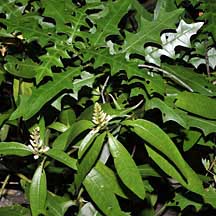 Sometimes the same plant may have spiky as well as smooth leaves. Kranji Nature Trail, Jan 09 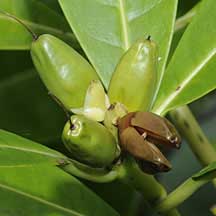 Exploded fruit capsule. Kranji Canal, Mar 09 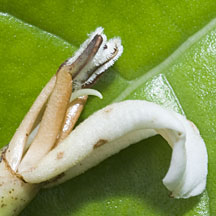 Flower structure to allow the flower to pick up pollen from insect visitors before deposting pollen as they depart. Kranji Nature Trail, Jan 13 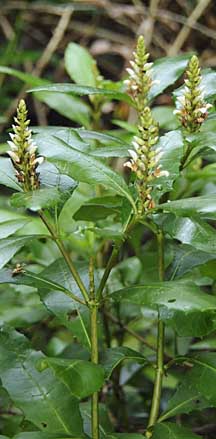 Kranji Nature Trail, Sep 09 |
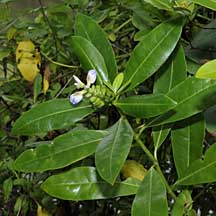 Kranji Canal, Mar 09 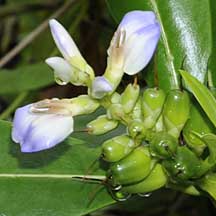 |
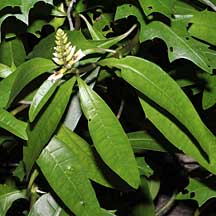 Kranji Nature Trail, Jan 09 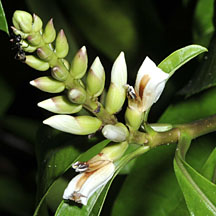 |
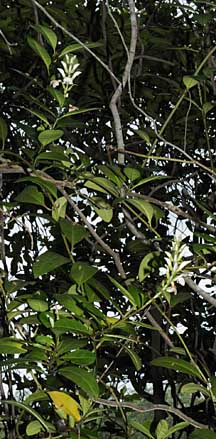 Sometimes scrambling up trees. Pulau Ubin, Aug 09 |
| Jeruju on Singapore shores |
| Photos of Jeruju for free download from wildsingapore flickr |
| Distribution in Singapore on this wildsingapore flickr map |
|
Links
References
|
|
|